headlamp GMC ENVOY DENALI 2009 Owner's Manual
[x] Cancel search | Manufacturer: GMC, Model Year: 2009, Model line: ENVOY DENALI, Model: GMC ENVOY DENALI 2009Pages: 474, PDF Size: 2.54 MB
Page 269 of 474
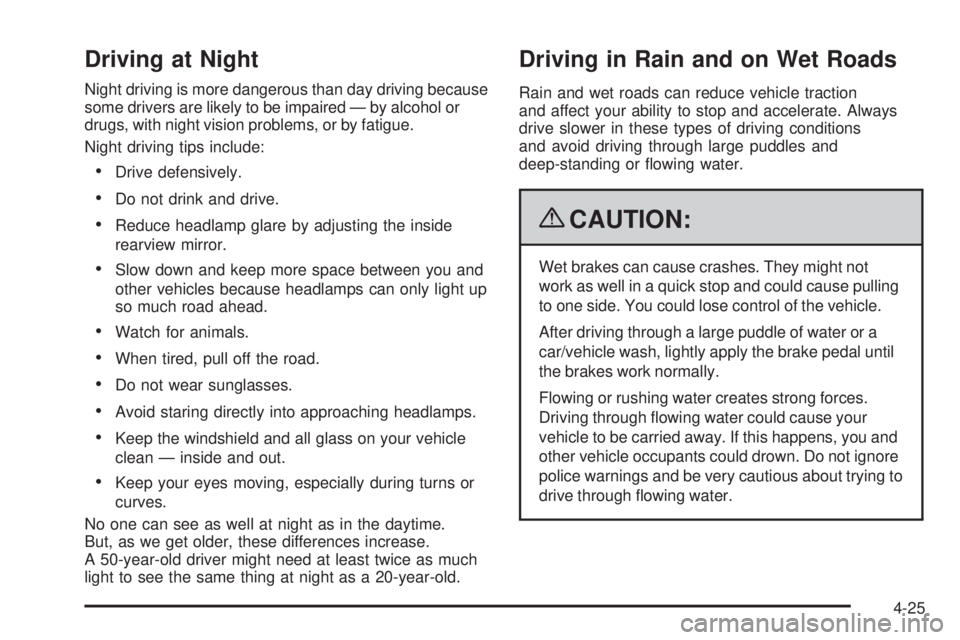
Driving at Night
Night driving is more dangerous than day driving because
some drivers are likely to be impaired — by alcohol or
drugs, with night vision problems, or by fatigue.
Night driving tips include:
Drive defensively.
Do not drink and drive.
Reduce headlamp glare by adjusting the inside
rearview mirror.
Slow down and keep more space between you and
other vehicles because headlamps can only light up
so much road ahead.
Watch for animals.
When tired, pull off the road.
Do not wear sunglasses.
Avoid staring directly into approaching headlamps.
Keep the windshield and all glass on your vehicle
clean — inside and out.
Keep your eyes moving, especially during turns or
curves.
No one can see as well at night as in the daytime.
But, as we get older, these differences increase.
A 50-year-old driver might need at least twice as much
light to see the same thing at night as a 20-year-old.
Driving in Rain and on Wet Roads
Rain and wet roads can reduce vehicle traction
and affect your ability to stop and accelerate. Always
drive slower in these types of driving conditions
and avoid driving through large puddles and
deep-standing or �owing water.
{CAUTION:
Wet brakes can cause crashes. They might not
work as well in a quick stop and could cause pulling
to one side. You could lose control of the vehicle.
After driving through a large puddle of water or a
car/vehicle wash, lightly apply the brake pedal until
the brakes work normally.
Flowing or rushing water creates strong forces.
Driving through �owing water could cause your
vehicle to be carried away. If this happens, you and
other vehicle occupants could drown. Do not ignore
police warnings and be very cautious about trying to
drive through �owing water.
4-25
Page 273 of 474

CAUTION: (Continued)
Open a window about two inches (5 cm) on
the side of the vehicle that is away from the
wind to bring in fresh air.
Fully open the air outlets on or under the
instrument panel.
Adjust the Climate Control system to a setting
that circulates the air inside the vehicle and
set the fan speed to the highest setting. See
Climate Control System in the Index.
For more information about carbon monoxide, see
Engine Exhaust on page 2-37.
Snow can trap exhaust gases under your vehicle.
This can cause deadly CO (carbon monoxide) gas
to get inside. CO could overcome you and kill you.
You cannot see it or smell it, so you might not
know it is in your vehicle. Clear away snow from
around the base of your vehicle, especially any
that is blocking the exhaust.Run the engine for short periods only as needed to
keep warm, but be careful.
To save fuel, run the engine for only short periods as
needed to warm the vehicle and then shut the engine
off and close the window most of the way to save heat.
Repeat this until help arrives but only when you feel
really uncomfortable from the cold. Moving about
to keep warm also helps.
If it takes some time for help to arrive, now and then when
you run the engine, push the accelerator pedal slightly so
the engine runs faster than the idle speed. This keeps the
battery charged to restart the vehicle and to signal for
help with the headlamps. Do this as little as possible to
save fuel.
4-29
Page 301 of 474

The seven-wire harness contains the following trailer
circuits:
Yellow: Left Stop/Turn Signal
Dark Green: Right Stop/Turn Signal
Brown: Running Lamps
White: Ground
Light Green: Back-up Lamps
Red: Battery Feed
Dark Blue: Electric BrakesIf towing a light-duty trailer with a standard four-way
round pin connector, an adapter connector is available
from your dealer/retailer.
If charging a remote (non-vehicle) battery, turn on the
headlamps to boost the vehicle system voltage and
properly charge the battery.
The vehicle is also equipped with wiring for an
electric trailer brake controller. These wires are
located inside the vehicle on the driver side under the
instrument panel. These wires should be connected
to an electric trailer brake controller by your
dealer/retailer or a quali�ed service center.
4-57
Page 303 of 474
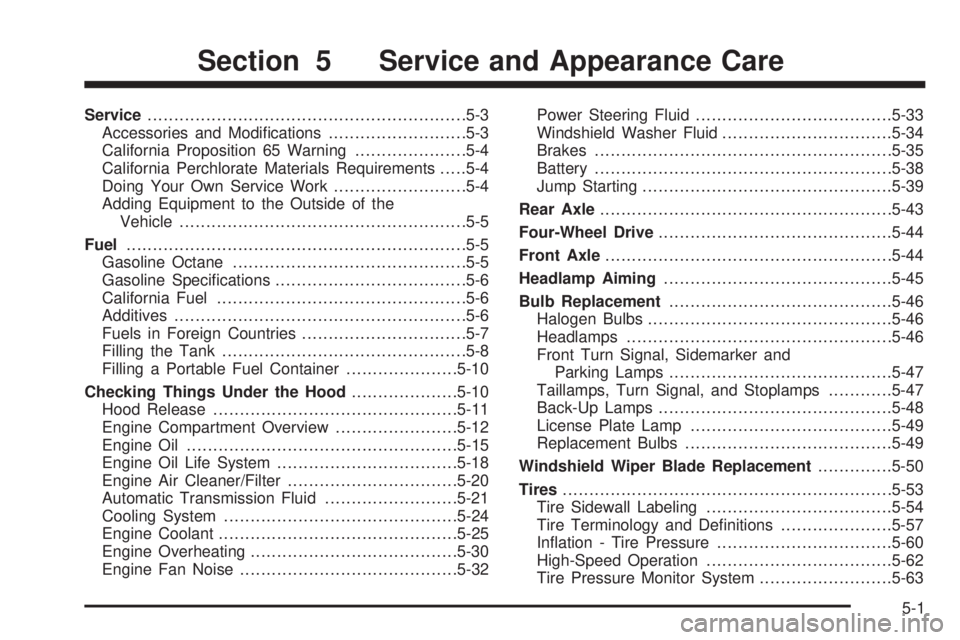
Service............................................................5-3
Accessories and Modi�cations..........................5-3
California Proposition 65 Warning.....................5-4
California Perchlorate Materials Requirements.....5-4
Doing Your Own Service Work.........................5-4
Adding Equipment to the Outside of the
Vehicle......................................................5-5
Fuel................................................................5-5
Gasoline Octane............................................5-5
Gasoline Speci�cations....................................5-6
California Fuel...............................................5-6
Additives.......................................................5-6
Fuels in Foreign Countries...............................5-7
Filling the Tank..............................................5-8
Filling a Portable Fuel Container.....................5-10
Checking Things Under the Hood....................5-10
Hood Release..............................................5-11
Engine Compartment Overview.......................5-12
Engine Oil...................................................5-15
Engine Oil Life System..................................5-18
Engine Air Cleaner/Filter................................5-20
Automatic Transmission Fluid.........................5-21
Cooling System............................................5-24
Engine Coolant.............................................5-25
Engine Overheating.......................................5-30
Engine Fan Noise.........................................5-32Power Steering Fluid.....................................5-33
Windshield Washer Fluid................................5-34
Brakes........................................................5-35
Battery........................................................5-38
Jump Starting...............................................5-39
Rear Axle.......................................................5-43
Four-Wheel Drive............................................5-44
Front Axle......................................................5-44
Headlamp Aiming
...........................................5-45
Bulb Replacement..........................................5-46
Halogen Bulbs..............................................5-46
Headlamps..................................................5-46
Front Turn Signal, Sidemarker and
Parking Lamps..........................................5-47
Taillamps, Turn Signal, and Stoplamps............5-47
Back-Up Lamps............................................5-48
License Plate Lamp......................................5-49
Replacement Bulbs.......................................5-49
Windshield Wiper Blade Replacement..............5-50
Tires..............................................................5-53
Tire Sidewall Labeling...................................5-54
Tire Terminology and De�nitions.....................5-57
In�ation - Tire Pressure.................................5-60
High-Speed Operation...................................5-62
Tire Pressure Monitor System.........................5-63
Section 5 Service and Appearance Care
5-1
Page 304 of 474
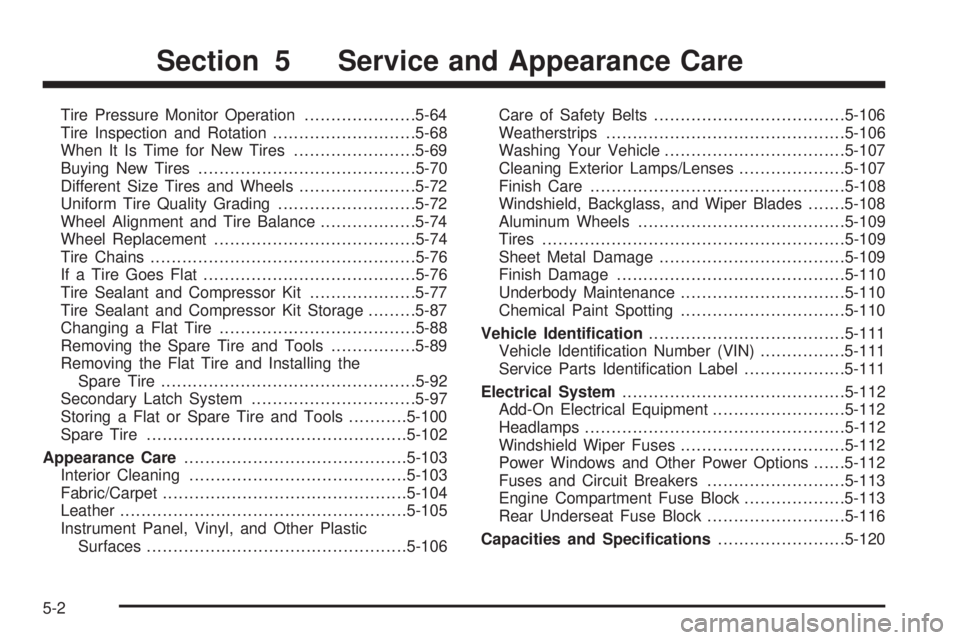
Tire Pressure Monitor Operation.....................5-64
Tire Inspection and Rotation...........................5-68
When It Is Time for New Tires.......................5-69
Buying New Tires.........................................5-70
Different Size Tires and Wheels......................5-72
Uniform Tire Quality Grading..........................5-72
Wheel Alignment and Tire Balance..................5-74
Wheel Replacement......................................5-74
Tire Chains..................................................5-76
If a Tire Goes Flat........................................5-76
Tire Sealant and Compressor Kit....................5-77
Tire Sealant and Compressor Kit Storage.........5-87
Changing a Flat Tire.....................................5-88
Removing the Spare Tire and Tools................5-89
Removing the Flat Tire and Installing the
Spare Tire................................................5-92
Secondary Latch System...............................5-97
Storing a Flat or Spare Tire and Tools...........5-100
Spare Tire.................................................5-102
Appearance Care..........................................5-103
Interior Cleaning.........................................5-103
Fabric/Carpet..............................................5-104
Leather......................................................5-105
Instrument Panel, Vinyl, and Other Plastic
Surfaces.................................................5-106Care of Safety Belts....................................5-106
Weatherstrips.............................................5-106
Washing Your Vehicle..................................5-107
Cleaning Exterior Lamps/Lenses....................5-107
Finish Care................................................5-108
Windshield, Backglass, and Wiper Blades.......5-108
Aluminum Wheels.......................................5-109
Tires.........................................................5-109
Sheet Metal Damage...................................5-109
Finish Damage...........................................5-110
Underbody Maintenance...............................5-110
Chemical Paint Spotting...............................5-110
Vehicle Identi�cation.....................................5-111
Vehicle Identi�cation Number (VIN)................5-111
Service Parts Identi�cation Label...................5-111
Electrical System..........................................5-112
Add-On Electrical Equipment.........................5-112
Headlamps.................................................5-112
Windshield Wiper Fuses...............................5-112
Power Windows and Other Power Options......5-112
Fuses and Circuit Breakers..........................5-113
Engine Compartment Fuse Block...................5-113
Rear Underseat Fuse Block..........................5-116
Capacities and Speci�cations........................5-120
Section 5 Service and Appearance Care
5-2
Page 347 of 474
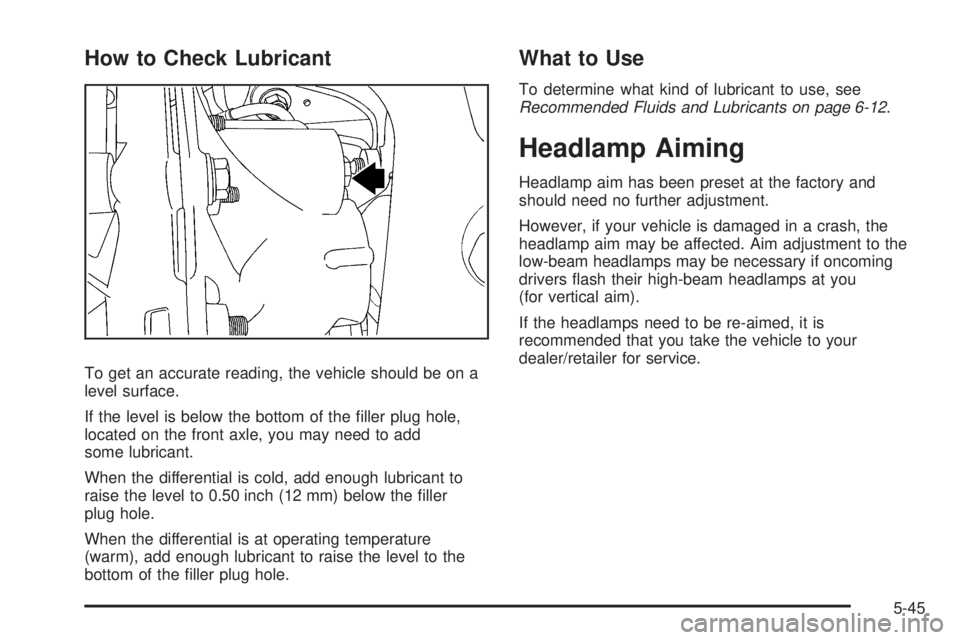
How to Check Lubricant
To get an accurate reading, the vehicle should be on a
level surface.
If the level is below the bottom of the �ller plug hole,
located on the front axle, you may need to add
some lubricant.
When the differential is cold, add enough lubricant to
raise the level to 0.50 inch (12 mm) below the �ller
plug hole.
When the differential is at operating temperature
(warm), add enough lubricant to raise the level to the
bottom of the �ller plug hole.
What to Use
To determine what kind of lubricant to use, see
Recommended Fluids and Lubricants on page 6-12.
Headlamp Aiming
Headlamp aim has been preset at the factory and
should need no further adjustment.
However, if your vehicle is damaged in a crash, the
headlamp aim may be affected. Aim adjustment to the
low-beam headlamps may be necessary if oncoming
drivers �ash their high-beam headlamps at you
(for vertical aim).
If the headlamps need to be re-aimed, it is
recommended that you take the vehicle to your
dealer/retailer for service.
5-45
Page 348 of 474

Bulb Replacement
For the proper type of replacement bulbs, see
Replacement Bulbs on page 5-49.
For any bulb changing procedure not listed in this
section, contact your dealer/retailer.
Halogen Bulbs
{CAUTION:
Halogen bulbs have pressurized gas inside and
can burst if you drop or scratch the bulb. You or
others could be injured. Be sure to read and follow
the instructions on the bulb package.
Headlamps
To replace one of these bulbs:
1. Open the hood.Hood Release on page 5-11.
2. Lift the two headlamp retaining clips.3. Pull the headlamp assembly away from the vehicle
to access the electrical connectors.
4. Remove the cover from the headlamp bulb.
5. Turn the bulb socket counterclockwise and remove it.
6. Disconnect the electrical connector from the old bulb.
7. Plug the electrical connector into the new bulb using
care not to touch the glass with your �ngers.
8. Turn the socket clockwise to reinstall it.
9. Reinstall the headlamp cover.
10. Push the headlamp assembly toward the vehicle.
11. Press down on the headlamp retaining clips to
secure the headlamp assembly.
5-46
Page 349 of 474

Front Turn Signal, Sidemarker and
Parking Lamps
To replace one of these bulbs:
1. Follow Steps 1 through 3 underHeadlamps on
page 5-46to access the front turn signal,
sidemarker or parking lamp.
2. Turn the bulb socket counterclockwise and remove
it from the lamp assembly.
3. Holding the socket, pull the old bulb to release it
from the socket.
4. Push the new bulb into the socket until it clicks.
5. Insert the bulb socket into the lamp assembly and
turn it clockwise to secure.
6. Reinstall the headlamp assembly by lining up the
headlamp assembly with the slots in the headlamp
retaining clips.
7. Press down on the headlamp retaining clips to
secure the headlamp assembly.
Taillamps, Turn Signal, and
Stoplamps
To replace a stoplamp/taillamp or turn signal bulb:
1. Open the liftgate. SeeLiftgate/Liftglass on
page 2-12.
2. Remove the
two screws from
the taillamp
assembly.
3. Pull the assembly away from the vehicle.
5-47
Page 351 of 474
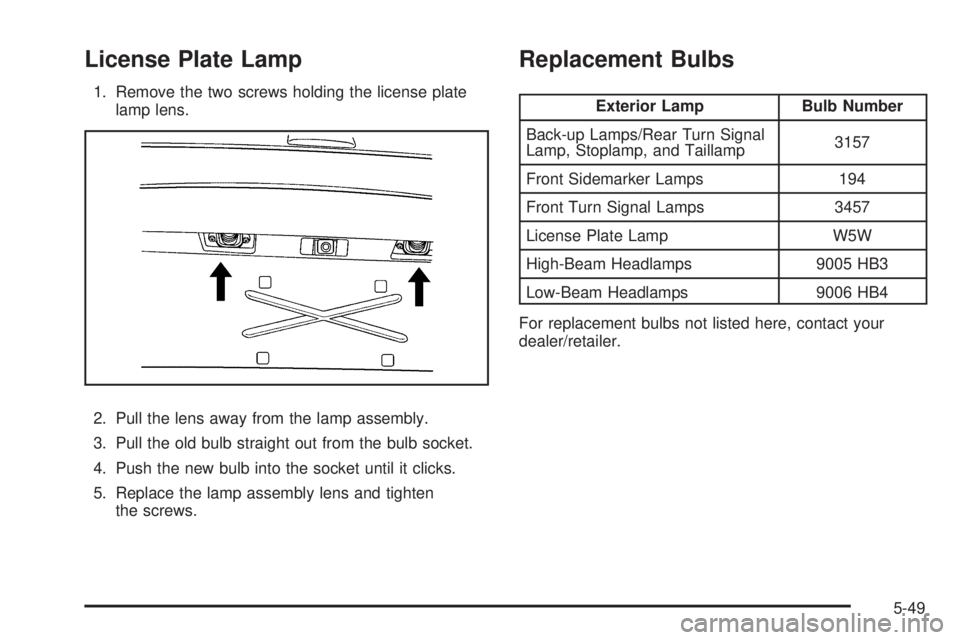
License Plate Lamp
1. Remove the two screws holding the license plate
lamp lens.
2. Pull the lens away from the lamp assembly.
3. Pull the old bulb straight out from the bulb socket.
4. Push the new bulb into the socket until it clicks.
5. Replace the lamp assembly lens and tighten
the screws.
Replacement Bulbs
Exterior Lamp Bulb Number
Back-up Lamps/Rear Turn Signal
Lamp, Stoplamp, and Taillamp3157
Front Sidemarker Lamps 194
Front Turn Signal Lamps 3457
License Plate Lamp W5W
High-Beam Headlamps 9005 HB3
Low-Beam Headlamps 9006 HB4
For replacement bulbs not listed here, contact your
dealer/retailer.
5-49
Page 369 of 474

The TPMS sensors can also be matched to each
tire/wheel position by increasing or decreasing the tire’s
air pressure. If increasing the tire’s air pressure, do
not exceed the maximum in�ation pressure indicated
on the tire’s sidewall.
To decrease air-pressure out of a tire you can use the
pointed end of the valve cap, a pencil-style air pressure
gage, or a key.
You have two minutes to match the �rst tire/wheel
position, and �ve minutes overall to match all four
tire/wheel positions. If it takes longer than two minutes,
to match the �rst tire and wheel, or more than �ve
minutes to match all four tire and wheel positions the
matching process stops and you need to start over.
The TPMS sensor matching process is outlined below:
1. Set the parking brake.
2. Turn the ignition switch to ON/RUN with the
engine off.
3. Turn the headlamp control from off to parking lamps
four times within three seconds. A double horn
chirp will sound and the TPMS low tire warning
light will begin to �ash. The double horn chirp and
�ashing TPMS warning light indicate that the
TPMS matching process has started. The TPMS
warning light should continue �ashing throughout
the matching procedure.
4. Start with the driver side front tire.5. Remove the valve cap from the valve cap stem.
Activate the TPMS sensor by increasing or
decreasing the tire’s air pressure for 10 seconds,
then stop and listen for a single horn chirp.
The single horn chirp should sound within
15 seconds, con�rming that the sensor identi�cation
code has been matched to this tire and wheel
position. If you do not hear the con�rming single
horn chirp, you will need to start over with step
number one.
6. Proceed to the passenger side front tire, and repeat
the procedure in Step 5.
7. Proceed to the passenger side rear tire, and repeat
the procedure in Step 5.
8. Proceed to the driver side rear tire, and repeat the
procedure in Step 5.
9. After hearing the con�rming horn chirp for the
driver’s side rear tire, check to see if the TPMS
warning light is still �ashing. If yes, turn the ignition
switch to LOCK/OFF to exit the sensor matching
process. If the TPMS warning light is not �ashing,
the �ve minute time limit has passed and you
will need to start the process over beginning with
Step 1.
10. Set all four tires to the recommended air pressure
level as indicated on the Tire and Loading
Information label.
11. Put the valve caps back on the valve stems.
5-67